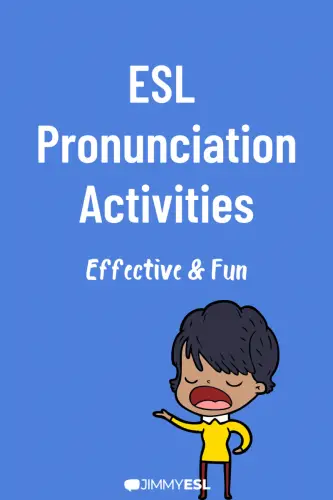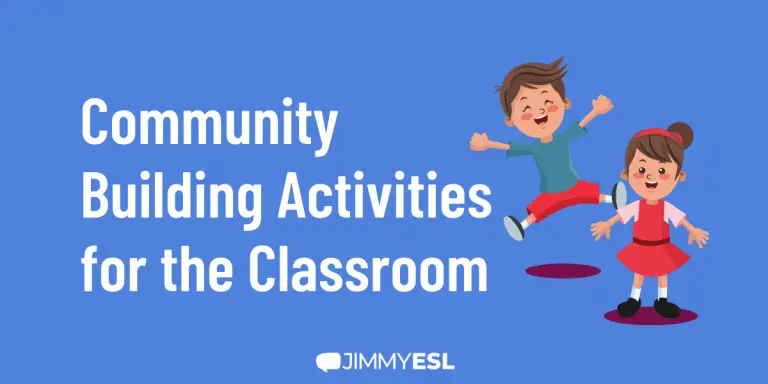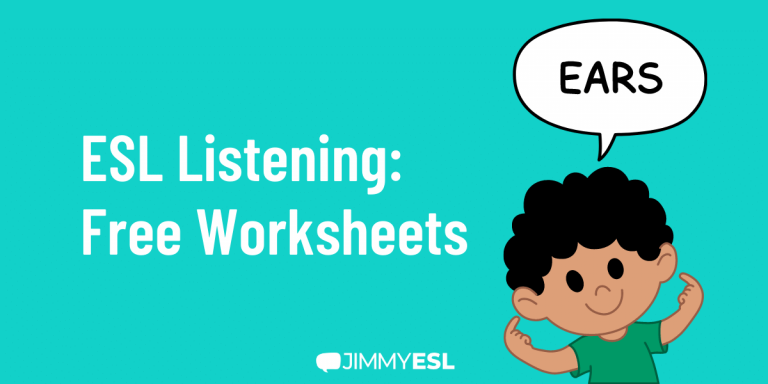12 ESL Pronunciation Activities to Practice With Your Students
Correct me if I’m wrong: when teachers teach English, what they neglect most is pronunciation, and when students learn English, what they neglect most is pronunciation.
Teaching and learning pronunciation in ESL classes can be really tricky for both teachers and students, but the good, old “practice makes perfect” does wonders as always.
Are you looking for ESL pronunciation activities that will improve your students’ pronunciation? Then check out my list of pronunciation tips and 12 activities for both preschool and advanced ESL students.

Why Teaching Pronunciation Matters?
We can all agree that there’s simply not enough time to practice all core activities in class, so we usually prioritize grammar, reading or writing.
Then no wonder why our students also think that pronunciation is not SO relevant, and forget that regardless their knowledge in grammar or vocabulary, if pronunciation fails, communication will also fail.
To speak comfortably, students must learn the basics of phonics, i.e. pronunciation, which would immediately improve their listening comprehension skills. When they learn how to pronounce “free” and “three”, they will easily distinguish these two words when listening.
What Is Good Pronunciation?
Unlike the popular belief, good pronunciation doesn’t necessarily mean to sound “like a native”.
To start with, it is hard to say what “a native” really sounds like, especially when it comes to English, a language that encompasses many language variations that express diversity in pronunciation.
When you practice pronunciation, include activities that encourage slow, easy and smooth speaking even when sounds are not perfect.
Next, add activities that focus solely on accuracy, i.e. how to produce sounds correctly.
Ready? Here are my favorite activities for adults and advanced students, as well as as for preschool students or beginners.
Pronunciation Activities for Adults and Advanced ESL Students
Let’s start with some advanced activities:
1. Fast Dictation
- Student level: Intermediate–Advanced
- Type of lesson: Group or individual
In this activity, the teacher dictates the content in a single continuous stream, without breaks.
The students listen and write words and phrases they notice.
The dictation should include target words in minimal pairs, e.g., bent — vent, thumb — sum, save — safe, that students need to detect and write in the order they hear them.
Learn how to conduct a running dictation activity.
2. Homophone Go Fish
- Student level: Pre-Intermediate–Advanced
- Type of lesson: Group
Make a list of homophones, and write each word on a separate piece of paper/ card.
Plan ahead the number of cards according to the number of participatory groups.
Each group member gets 5 cards, the rest is put in a pile.
The goal of the game is students to find a matching homophone by asking another student: “Do you have a word that sounds like…?” (for example, sun – son).
To keep the pair, Student 1 has to use the matching words in 1- 2 sentences.
In case Student 2 doesn’t have the homophone, they say, “Go fish!” and Student 1 draws a card from the pile.
3. Rhyming Poetry
- Student level: Pre-Intermediate–Advanced
- Type of lesson: Group or Individual
You can do this activity both face-to-face and online.
Instruct your students to write a simple poem with rhymes, e.g., love — dove, face — embrace, and read it out loud.
This activity is especially convenient and inspirative when related to a festive occasion like St. Valentine’s Day, Christmas or Earth’s Day.
4. Sound Chain
- Student level: Intermediate–Advanced
- Type of lesson: Group
Another activity that you can do both face-to-face and online.
Students should line up or take a designated order in the class if online.
Give your students a key sound, e.g., “ue” — like in fuel, due, tissue, rescue. Then instruct each student to find a word with the same sound.
Have your class tell a story with the words that were listed during the sound chain game in the exact order. (take notes of the order, just in case your students forget it).
5. The Odd One Out
- Student level: Intermediate–Advanced
- Type of lesson: Group
Prepare a list with several sets of 3-4 words with the same vowel sound. Add one word in the middle that differs from the rest, like meet, sit, meat, seat.
Divide the class into teams and instruct them to line into 2 lines in front of the board.
Write the first set of words on the board. The first student row reads the words, then goes fast to the board and circles the odd word.
The student who first circles the odd words wins a point for the team.
6. Extra Drill: Pronunciation Check
Check how well your students can pronounce the following mispronounced English words:
Pronunciation Activities for Preschool ESL Students
Now, these activities are fun and effective for beginners and kids:
7. Sound TPR
- Student level: Beginner–Elementary
- Type of lesson: Group
Designate movements to specific sounds, for example, clapping, stumping or raising hands.
For example, when students hear the sound ‘oi” in oil or boil, they jump or wave their arms.
You can read to them, play an audio or show flashcards and encourage them to respond to the words on the flashcards with correct pronunciation and movement.
8. Fruit Salad
- Student level: Beginner–Elementary
- Type of lesson: Group
Instruct students to sit in a circle and have one student standing in the middle.
Each student represents a type of fruit, i.e. words containing minimal pairs (pin, bin).
The student in the middle calls a fruit and all students who represent that fruit have to quickly change places while the student in the middle tries to take one of their chairs.
From time to time, they can say “fruit salad”, i.e. another word (bean!) and then all students have to change places.
9. Pronunciation Bingo
- Student level: Beginner–Pre-Intermediate
- Type of lesson: Group
Prepare Bingo sheets with words for each individual sound you want to review, as well as sound flashcards.
Show a sound flashcard and say the sound while showing the card.
The students must find the word on the Bingo sheet that matches the sound.
E.g., “e” – “pet”.
10. Correct the Teacher
- Student level: Beginner–Elementary
- Type of lesson: Group or Individual
Say a sentence in both natural and unnatural rhythm and ask your students to decide if it was right or wrong. If wrong, they need to say it in the correct way.
E.g., “I fond tree keys in the box.” (I found three keys in the box.)
11. Rhyming Pair Memo Game
- Student level: Beginner–Elementary
- Type of lesson: Group or Individual
Prepare cards with rhyming words like pet-bat, man-can etc., and put them face down. Students take turns and turn over the cards to find the rhyming pairs.
12. Extra Drill: Tongue Twister + Role Play
Play this video to your students (minute 00:00-07:00). Explain to them what is a tongue twister: A sentence made up of words that are difficult to pronounce quickly, e.g., “She sells sea shells on the sea shore.”
Replay the video and encourage students to repeat the 3 tongue twisters. Then assign a role to each student or divide students in groups where each would get a role if they’re too many, and do the role play demonstrated in minute 07:00-13:25.
Follow-up…
To improve students pronunciation, try to stay diligent in implementing ESL pronunciation activities and establish routinely follow-ups of their progress, so you can detect any impediments and work on these accordingly.
Stay committed and results will follow!
Check out out our extensive guide on teaching English pronunciation with more tips and exercises.





